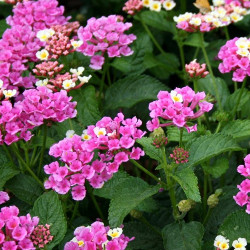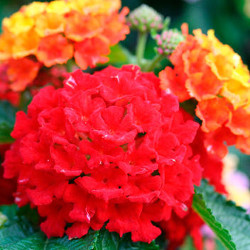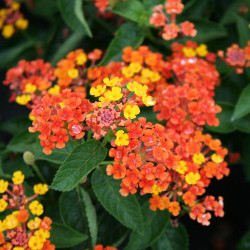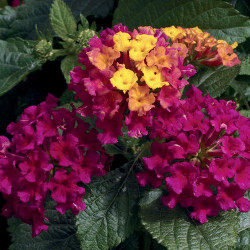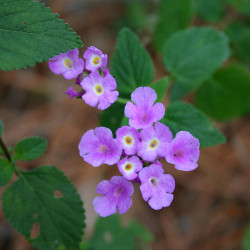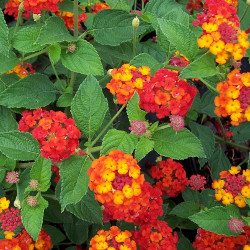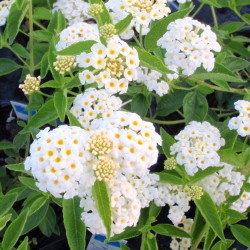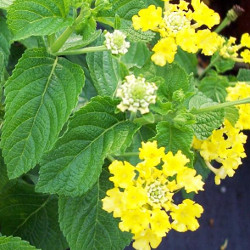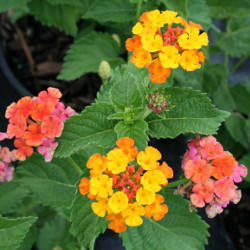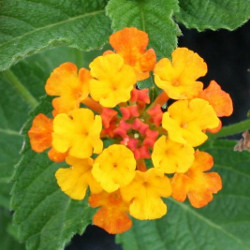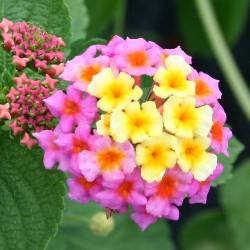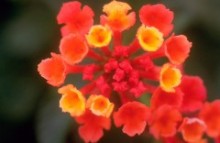
Colorful Lantana Loves Full Sun:
Low Maintenance "King"
of the Butterfly Garden
Hardy Lantana is a rewarding plant to grow in North Florida gardens. Fast growing, it loves full sun, is drought tolerant once established, and is attractive to butterflies, hummingbirds and honey bees.
Flowers are prolific from the first warmth of summer until frost. And for those avid gardeners whose best efforts become a smörgåsbord for deer, it is a deer resistant plant.
Lantana tolerates most soil types well. Some tolerate salt spray and are grown in coastal areas all around the Gulf Coast.
Lantana is a low maintenance plant and is perfect for creating an English Cottage Garden in the landscape. They require little care other than a good pruning in the fall to encourage more compact growth in the spring. They should be pruned to a height of 6″ to 10″.
Characteristics
Lantana come in many colors and sizes. Highly aromatic, the flower clusters are a mix of red, orange, pink and yellow or blue and white. The colors of some varieties change as they mature, resulting in bi-color or even tri-color blossoms.
The various species range in size from short, 12″ border plants to 6′ x 6′ towering specimens for a backdrop in the garden. Some, like the L. montevidensis have a more vine-like trailing habit and are suitable either as a ground cover or for hanging baskets.
Taxonomy and Hardiness
Lantana are a large genus of about 150 species of perennial shrubs in the Verbena family (Verbenaceae), and are native to South Florida, South America and South Africa. Officially classified as tropical and tender perennials, they can be grown in zones 2 – 11. However, they are only evergreen and perennial in zones 9 – 11. Most become deciduous at 28°.
Sun and Soil Requirements
Lantana prefer full sun. They tolerate partial shade but will easily become more leggy and produce less flowers. They prefer a well drained, light soil and are drought tolerant once established. Though not picky about the soil type, Lantana do not like it too rich.
Wildlife attracted by Lantana Plants
Butterflies love Lantana flowers, especially the swallowtail and the birdwing butterflies. The colorful Milkweed butterflies (Danainae) and Heleconiinae also feed on this plant. Even hummingbirds sip nectar from the abundant flowers.
Lantana are also useful as honey plants, giving valuable nectar to the bees. Often the L. lilacina and the L. trifolia are used for this purpose. The ripe fruit is a delicacy to many birds.
One creature you won’t find dining on a buffet of Lantana is the deer. It is a deer resistant plant.
Warnings
Even the most beautiful of flowers sometimes have negative characteristics. Some varieties of Lantana can be invasive in warm tropical climates. In addition, the leaves contain substances that can be toxic to grazing animals or pets, as well as cause rashes. Eating the unripe berries can be fatal. Be sure to caution young children appropriately.
Propagation
Lantana can be propagated either by seed or by woody stem cuttings.
Notable Species
Choose your Lantana carefully to fit the “look” you wish to achieve in the garden. Some are more suitable to backdrops, others as borders or hanging baskets. Most varieties are hybrids of either the L. camara or the L. montevidensis. Pictures and descriptions of commonly available varieties for our area can be found in the slider below.
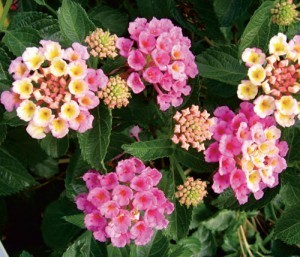
L. camara "Bandanna Pink"
Photo courtesy of Proven Winners
Lantana Camara is one of the most prolific of the Lantana family. Reaching heights up to 6′ tall, L. camara can spread as much as 8′ in diameter. Some are as compact as 2′ tall like the “New Gold”, a seedless golden yellow hybrid that is 16″ to 24″ tall. The colors of this species are reds, yellows, pinks and roses, whites and oranges, and many combinations in between. It is a non-stop bloomer. Leaves can be 2-5” long. This one also tolerates salt spray.
Lantana Montevidensis is called Weeping Lantana. It grows 6” to as much as 2′ tall with 5′ trailing branches bearing myriads of small flowers. The most common color is lilac. It can also be found in “White” and “Christine” (a yellow / magenta blend good only in zones 10 & 11). Leaves of this variety are only about an inch long. Great for a hanging basket or as a ground cover. A native of South America, it is being cultivated in many areas of the South.
Lantana Achyranthifolia is a soft purple color that only grows in Texas, NM, and Arizona.
Lantana Involucrata, is also called Buttonsage. Its downy, oval leaves have toothed edges and It grows to about 3 feet tall. It has clusters of small, fragrant white and lavender flowers, followed by purple fruit. It is a native of both South Florida and South America. It loves full sun and dry soil.
References:
University of Texas at Austin Native Plant Database: Lantana Involucrata
USDA Plants Database: Lantana
Wikipedia: Lantana
Floridata: Lantana Camara
Floridata: Lantana Montevidensis
Top image courtesy of: Clarence A. Rechenthin @ USDA-NRCS PLANTS Database


